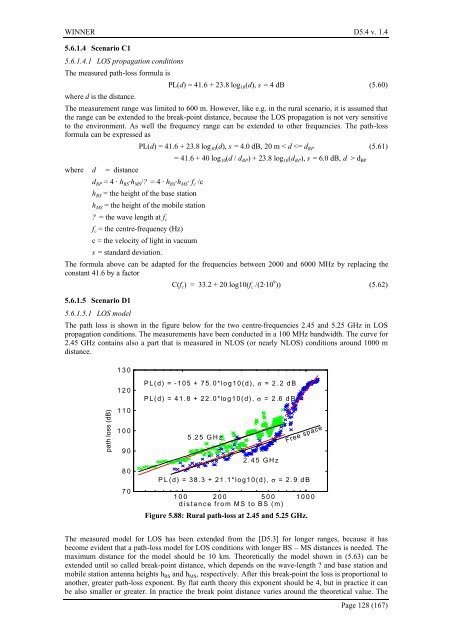Final report on link level and system level channel models - Winner
Final report on link level and system level channel models - Winner
Final report on link level and system level channel models - Winner
Create successful ePaper yourself
Turn your PDF publications into a flip-book with our unique Google optimized e-Paper software.
WINNER D5.4 v. 1.4<br />
5.6.1.4 Scenario C1<br />
5.6.1.4.1 LOS propagati<strong>on</strong> c<strong>on</strong>diti<strong>on</strong>s<br />
The measured path-loss formula is<br />
where d is the distance.<br />
PL(d) = 41.6 + 23.8 log 10 (d), s = 4 dB (5.60)<br />
The measurement range was limited to 600 m. However, like e.g. in the rural scenario, it is assumed that<br />
the range can be extended to the break-point distance, because the LOS propagati<strong>on</strong> is not very sensitive<br />
to the envir<strong>on</strong>ment. As well the frequency range can be extended to other frequencies. The path-loss<br />
formula can be expressed as<br />
where d = distance<br />
PL(d) = 41.6 + 23.8 log 10 (d), s = 4.0 dB, 20 m < d d BP<br />
The formula above can be adapted for the frequencies between 2000 <strong>and</strong> 6000 MHz by replacing the<br />
c<strong>on</strong>stant 41.6 by a factor<br />
5.6.1.5 Scenario D1<br />
5.6.1.5.1 LOS model<br />
C(f c ) = 33.2 + 20 log10(f c /(2·10 9 )) (5.62)<br />
The path loss is shown in the figure below for the two centre-frequencies 2.45 <strong>and</strong> 5.25 GHz in LOS<br />
propagati<strong>on</strong> c<strong>on</strong>diti<strong>on</strong>s. The measurements have been c<strong>on</strong>ducted in a 100 MHz b<strong>and</strong>width. The curve for<br />
2.45 GHz c<strong>on</strong>tains also a part that is measured in NLOS (or nearly NLOS) c<strong>on</strong>diti<strong>on</strong>s around 1000 m<br />
distance.<br />
130<br />
path loss (dB)<br />
120<br />
110<br />
100<br />
90<br />
80<br />
70<br />
PL(d) = -105 + 75.0*log10(d), σ = 2.2 dB<br />
PL(d) = 41.8 + 22.0*log10(d), σ = 2.6 dB<br />
5.25 GHz<br />
Free space<br />
2.45 GHz<br />
PL(d) = 38.3 + 21.1*log10(d), σ = 2.9 dB<br />
100 200 500 1000<br />
distance from MS to BS (m)<br />
Figure 5.88: Rural path-loss at 2.45 <strong>and</strong> 5.25 GHz.<br />
The measured model for LOS has been extended from the [D5.3] for l<strong>on</strong>ger ranges, because it has<br />
become evident that a path-loss model for LOS c<strong>on</strong>diti<strong>on</strong>s with l<strong>on</strong>ger BS – MS distances is needed. The<br />
maximum distance for the model should be 10 km. Theoretically the model shown in (5.63) can be<br />
extended until so called break-point distance, which depends <strong>on</strong> the wave-length ? <strong>and</strong> base stati<strong>on</strong> <strong>and</strong><br />
mobile stati<strong>on</strong> antenna heights h BS <strong>and</strong> h MS , respectively. After this break-point the loss is proporti<strong>on</strong>al to<br />
another, greater path-loss exp<strong>on</strong>ent. By flat earth theory this exp<strong>on</strong>ent should be 4, but in practice it can<br />
be also smaller or greater. In practice the break point distance varies around the theoretical value. The<br />
Page 128 (167)

















